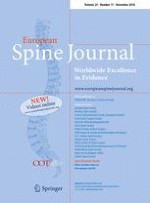Published in:

01-11-2016 | Original Article
Global tilt: a single parameter incorporating spinal and pelvic sagittal parameters and least affected by patient positioning
Authors:
I. Obeid, L. Boissière, C. Yilgor, D. Larrieu, F. Pellisé, A. Alanay, E. Acaroglu, F. J. Perez-Grueso, F. Kleinstück, J. M. Vital, A. Bourghli, on behalf of European Spine Study Group, ESSG
Published in:
European Spine Journal
|
Issue 11/2016
Login to get access
Abstract
Purpose
Regarding the close interaction between the spinal alignment and the pelvis orientation, no parameter is routinely used to describe and to evaluate the global spinopelvic balance, taking into account simultaneously the spinal part and the pelvic part of the global alignment. We described the global tilt (GT) that could analyze malalignment considering the spine and the pelvis simultaneously. From a geometrical point of view, the global tilt is the sum of the pelvic tilt (PT) and the C7 vertical tilt (angular value of sagittal vertical axis). The aim of this study is to evaluate the global tilt with comparison to PT and sagittal vertical axis (SVA), with the hypothesis that GT would be the least sensitive to positional changes.
Methods
A cohort of 22 patients with sagittal malalignment was identified from a multicentric database of adult spinal deformities (ASD). Inclusion criteria were age >30 years, SVA > 40 mm and/or PT > 20°. All patients had full spine EOS radiographs in positions 1 and 2 (P1 and P2), in which the patient was asked to stand and put his hands on his shoulders without any effort (P1), or to make an effort to be as straight as possible (P2). PT, SVA and GT were measured in both positions and changes between P1 and P2 were calculated and compared using Student’s t test with significance level at p < 0.05.
Results
No significant changes were observed for GT; SVA and PT were significantly influenced by patient positioning. SVA decreased and PT increased for all cases in P2 whereas the changes in GT were in either direction. The average increase in PT was 7.1° (±5.4) or 30.8 % (±24.9); decrease in SVA was 45.1 mm (±25.6) or 60.0 % (±44.2) while the change in GT was 4.4° (±3.3) or 12.6 % (±9.3).
Discussion
GT appears to be less affected by the patient’s position compared to SVA and PT. This seems logical because GT contains both spinal alignment and pelvic compensation; it is not affected by their changes in opposing directions.
Conclusion
GT appears to be the most reliable single sagittal plane parameter in ASD. It is the least affected by patient position and incorporates both the pelvic and the spinal alignment within one measure.